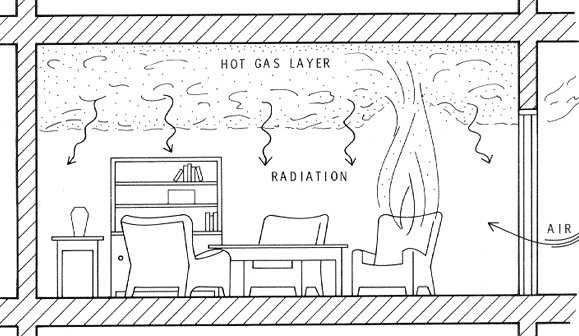밀폐된 방에서의 화재
밀폐된 방안에서도 어떤 물건이 타기 시작하여 처음 어느 정도의 시간 동안은 문이 열려 있는 상태와 같이 화재가 진행된다. 그러나 짧은 기간 후부터 밀폐의 영향을 받기 시작한다.
물체가 타면서 발생한 연기는 천장 바로 아래에 뜨거운 가스 층을 형성하여 천장과 방의 윗면 벽을 가열하게 된다. 이렇게 형성된 뜨거운 열기는 방안의 모든 물건의 온도를 높이게 된다. 원래 타던 물체에도 열을 더하여 더 빨리 타게 만들 수도 있다.
이 시점에서 만약, 예를 들어, 다른 물건에 불이 붙기 전에 원래 타고 있던 물체가 다 타버린 경우 혹은 만약 화재가 계속 유지되기에 산소의 유입이 충분하지 못한 경우에는 불이 꺼질 수도 있다.

When an object in a room starts to burn, for some time after ignition, it burns in much the same way as it would in the open. After a short period of time, however, confinement begins to influence fire development. The smoke produced by the burning object rises to form a hot gas layer below the ceiling; this layer heats the ceiling and upper walls of the room. Thermal radiation from the hot layer, ceiling, and upper walls begins to heat all objects in the lower part of the room and may augment both the rate of burning of the original object and the rate of flame spread over its surface.
At this point, the fire may go out if, for example, the first object burns completely before others start, or if sufficient oxygen cannot get into the room to keep the object burning.
J.R. Mehaffey, Ph.D.